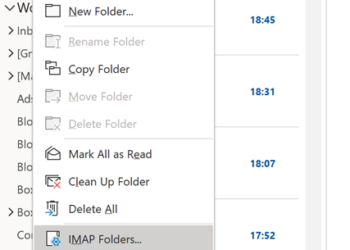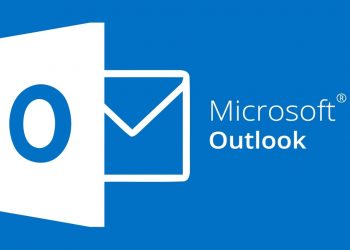Outlook 2010 should be available sometime in 2010 and has lots of new features included. We have already covered lots of tutorials and tips on getting more out of Outlook 2010. Shortcuts are the best way to improve productivity and like any other software, Outlook 2010 also has good number of shortcuts to improve productivity for emails. Here is the complete list of Outlook 2010 shortcuts.

|
Function in Outlook
|
Shortcut Key
|
|
Switch to Mail.
|
CTRL+1
|
|
Switch to Calendar.
|
CTRL+2
|
|
Switch to Contacts.
|
CTRL+3
|
|
Switch to Tasks.
|
CTRL+4
|
|
Switch to Notes.
|
CTRL+5
|
|
Switch to Folder List in Navigation Pane.
|
CTRL+6
|
|
Switch to Shortcuts.
|
CTRL+7
|
|
Switch to next message (with message open).
|
CTRL+PERIOD
|
|
Switch to previous message (with message open).
|
CTRL+COMMA
|
|
Move between the Navigation Pane, the main Outlook window, the Reading Pane, and the To-Do Bar.
|
CTRL+SHIFT+TAB or SHIFT+TAB
|
|
Move around message header lines in the Navigation Pane or an open message.
|
CTRL+TAB
|
|
Move around within the Navigation Pane.
|
Arrow keys
|
|
Go back to previous view in main Outlook window.
|
ALT+B or ALT+LEFT ARROW
|
|
Go to a different folder.
|
CTRL+Y
|
|
Go to the Search box.
|
F3 or CTRL+E
|
|
In the Reading Pane, go to the previous message.
|
ALT+UP ARROW or CTRL+COMMA or ALT+PAGE UP
|
|
In the Reading Pane, page down through text.
|
SPACEBAR
|
|
In the Reading Pane, page up through text.
|
SHIFT+SPACEBAR
|
|
Go forward to next view in main Outlook window.
|
ALT+RIGHT ARROW
|
|
Switch to Inbox.
|
CTRL+SHIFT+I
|
|
Switch to Outbox.
|
CTRL+SHIFT+O
|
|
Check names.
|
CTRL+K
|
|
Send.
|
ALT+S
|
|
Reply to a message.
|
CTRL+R
|
|
Reply all to a message.
|
CTRL+SHIFT+R
|
|
Reply with meeting request.
|
CTRL+ALT+R
|
|
Forward a message.
|
CTRL+F
|
|
Mark a message as not junk.
|
CTRL+ ALT+J
|
|
Display blocked external content (in a message).
|
CTRL+SHIFT+I
|
|
Post to a folder.
|
CTRL+ SHIFT+S
|
|
Apply Normal style.
|
CTRL+SHIFT+N
|
|
Check for new messages.
|
CTRL+M or F9
|
|
Go to the previous message.
|
UP ARROW
|
|
Go to the next message.
|
DOWN ARROW
|
|
Create a message (when in Mail).
|
CTRL+N
|
|
Create a message (from any Outlook view).
|
CTRL+SHIFT+M
|
|
Open a received message.
|
CTRL+O
|
|
Delete and Ignore a Conversation.
|
CTRL+SHIFT+D
|
|
Open the Address Book.
|
CTRL+SHIFT+B
|
|
Add a Quick Flag to an unopened message.
|
INSERT
|
|
Display the Flag for Follow Up dialog box.
|
CTRL+SHIFT+G
|
|
Mark as read.
|
CTRL+Q
|
|
Mark as unread.
|
CTRL+U
|
|
Open the Mail Tip in the selected message.
|
CTRL+SHIFT+W
|
|
Find or replace.
|
F4
|
|
Find next.
|
SHIFT+F4
|
|
Send.
|
CTRL+ENTER
|
|
Print.
|
CTRL+P
|
|
Forward.
|
CTRL+F
|
|
Forward as attachment.
|
CTRL+ALT+F
|
|
Show the properties for the selected item.
|
ALT+ENTER
|
|
Create a multimedia message
|
CTRL+SHIFT+U
|
|
Create a text message.
|
CTRL+SHIFT+T
|
|
Mark for Download.
|
CTRL+ALT+M
|
|
Clear Mark for Download.
|
CTRL+ALT+U
|
|
Send and Receive
|
F9
|
|
Display Send/Receive progress.
|
CTRL+B (when a Send/Receive is in progress)
|
|
Dial a new call.
|
CTRL+SHIFT+D
|
|
Find a contact or other item (Search).
|
F3 or CTRL+E
|
|
Enter a name in the Search Address Books box.
|
F11
|
|
In Table or List view of contacts, go to first contact that starts with a specific letter.
|
SHIFT+letter
|
|
Select all contacts.
|
CTRL+A
|
|
Create a message with selected contact as subject.
|
CTRL+F
|
|
Create a Journal entry for the selected contact.
|
CTRL+J
|
|
Create a new contact (when in Contacts).
|
CTRL+N
|
|
Create a new contact (from any Outlook view).
|
CTRL+SHIFT+C
|
|
Open a contact form for the selected contact.
|
CTRL+O
|
|
Create a distribution list.
|
CTRL+SHIFT+L
|
|
Print.
|
CTRL+P
|
|
Update a list of distribution list members.
|
F5
|
|
Go to a different folder.
|
CTRL+Y
|
|
Open the Address Book.
|
CTRL+SHIFT+B
|
|
Use Advanced Find.
|
CTRL+SHIFT+F
|
|
In an open contact, open the next contact listed.
|
CTRL+SHIFT+PERIOD
|
|
Find a contact.
|
F11
|
|
Close a contact.
|
ESC
|
|
Send a fax to the selected contact.
|
CTRL+SHIFT+X
|
|
Create a new appointment (when in Calendar).
|
CTRL+N
|
|
Create a new appointment (in any Outlook view).
|
CTRL+SHIFT+A
|
|
Create a new meeting request.
|
CTRL+SHIFT+Q
|
|
Forward an appointment or meeting.
|
CTRL+F
|
|
Reply to a meeting request with a message.
|
CTRL+R
|
|
Reply All to a meeting request with a message.
|
CTRL+SHIFT+R
|
|
Show 10 days in the calendar.
|
ALT+0
|
|
Show 1 day in the calendar.
|
ALT+1
|
|
Show 2 days in the calendar.
|
ALT+2
|
|
Show 3 days in the calendar.
|
ALT+3
|
|
Show 4 days in the calendar.
|
ALT+4
|
|
Show 5 days in the calendar.
|
ALT+5
|
|
Show 6 days in the calendar.
|
ALT+6
|
|
Show 7 days in the calendar.
|
ALT+7
|
|
Show 8 days in the calendar.
|
ALT+8
|
|
Show 9 days in the calendar.
|
ALT+9
|
|
Go to a date.
|
CTRL+G
|
|
Switch to Month view.
|
ALT+= or CTRL+ALT+4
|
|
Go to the next day.
|
CTRL+RIGHT ARROW
|
|
Go to the next week.
|
ALT+DOWN ARROW
|
|
Go to the next month.
|
ALT+PAGE DOWN
|
|
Go to the previous day.
|
CTRL+LEFT ARROW
|
|
Go to the previous week.
|
ALT+UP ARROW
|
|
Go to the previous month.
|
ALT+PAGE UP
|
|
Go to the start of the week.
|
ALT+HOME
|
|
Go to the end of the week.
|
ALT+END
|
|
Switch to Full Week view.
|
ALT+MINUS SIGN or CTRL+ALT+3
|
|
Switch to Work Week view.
|
CTRL+ALT+2
|
|
Go to previous appointment.
|
CTRL+COMMA or CTRL+SHIFT+COMMA
|
|
Go to next appointment.
|
CTRL+PERIOD or CTRL+SHIFT+PERIOD
|
|
Find a message or other item.
|
CTRL+E
|
|
Clear the search results.
|
ESC
|
|
Expand the search to include All Mail Items, All Calendar Items, or All Contact Items, depending on the module you are in.
|
CTRL+ALT+A
|
|
Use Advanced Find.
|
CTRL+SHIFT+F
|
|
Create a new Search Folder.
|
CTRL+SHIFT+P
|
|
Search for text within an open item.
|
F4
|
|
Find and replace text, symbols, or some formatting commands. Works in the Reading Pane on an open item.
|
CTRL+H
|
|
Expand search to include items from the current folder.
|
CTRL+ALT+K
|
|
Expand search to include subfolders.
|
CTRL+ALT+Z
|








How can we see attachments sent by us in reading pane